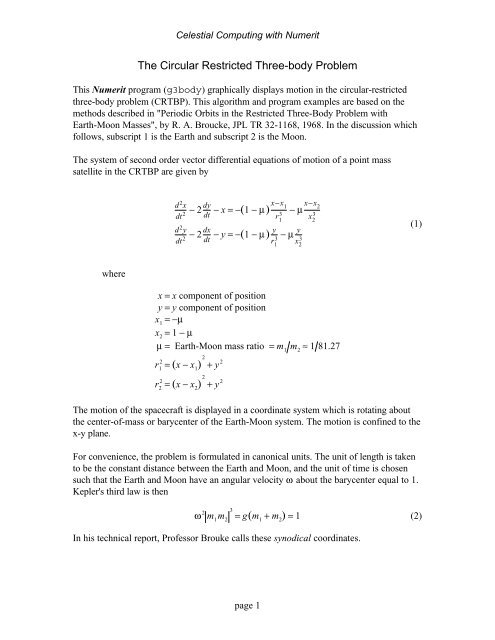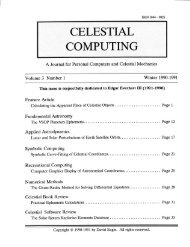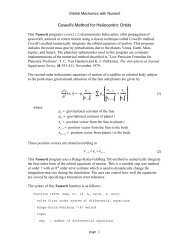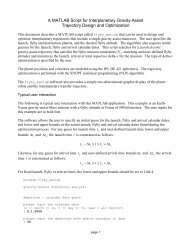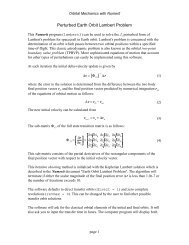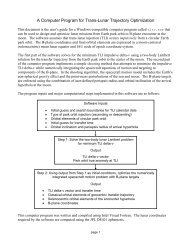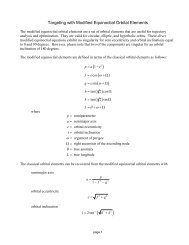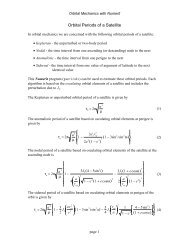The Circular Restricted Three-body Problem
The Circular Restricted Three-body Problem
The Circular Restricted Three-body Problem
- No tags were found...
You also want an ePaper? Increase the reach of your titles
YUMPU automatically turns print PDFs into web optimized ePapers that Google loves.
Celestial Computing with Numerit<strong>The</strong> <strong>Circular</strong> <strong>Restricted</strong> <strong>Three</strong>-<strong>body</strong> <strong>Problem</strong>This Numerit program (g3<strong>body</strong>) graphically displays motion in the circular-restrictedthree-<strong>body</strong> problem (CRTBP). This algorithm and program examples are based on themethods described in "Periodic Orbits in the <strong>Restricted</strong> <strong>Three</strong>-Body <strong>Problem</strong> withEarth-Moon Masses", by R. A. Broucke, JPL TR 32-1168, 1968. In the discussion whichfollows, subscript 1 is the Earth and subscript 2 is the Moon.<strong>The</strong> system of second order vector differential equations of motion of a point masssatellite in the CRTBP are given byd 2 xdt − 2 dy2 dt − x = −(1 − µ) x−x 1− µ x−x 2r13 x23d 2 ydt − 2 dxy− y = −(1 − µ) − µ y 2 dt r13 x23(1)wherex = x component of positiony = y component of positionx 1= −µx 2= 1 − µµ = Earth-Moon mass ratio = m 1m 2≈ 1 81.27r 2 1 = (x − x 1) 2 + y 2r 2 2 = (x − x 2) 2 + y 2<strong>The</strong> motion of the spacecraft is displayed in a coordinate system which is rotating aboutthe center-of-mass or barycenter of the Earth-Moon system. <strong>The</strong> motion is confined to thex-y plane.For convenience, the problem is formulated in canonical units. <strong>The</strong> unit of length is takento be the constant distance between the Earth and Moon, and the unit of time is chosensuch that the Earth and Moon have an angular velocity ω about the barycenter equal to 1.Kepler's third law is thenω 2 m 1m 23= g(m1 + m 2) = 1(2)In his technical report, Professor Brouke calls these synodical coordinates.page 1
Celestial Computing with NumeritIn his prize memoir of 1772, Joseph-Louis Lagrange proved that there are fiveequilibrium points in the circular-restricted three-<strong>body</strong> problem. If we place a satellite orcelestial <strong>body</strong> at one of these points with zero initial velocity, it will stay therepermanently. <strong>The</strong>se special positions are also called libration points.For the Earth-Moon mass ratio value of , the x and y coordinates of these five equilibriumpoints L iare as follows:L 1 x = +0.836892919 y = 0L 2 x = +1.155699520 y = 0L 3 x = -1.005064520 y = 0L 4 x = +0.487844901 y = +0.866025404L 5 x = +0.487844901 y = +0.866025404<strong>Three</strong> of these libration points are on the x-axis and the other two form equilateraltriangles with the positions of the Earth and Moon.<strong>The</strong> program begins by asking you to select from 4 main program options. <strong>The</strong> first threeoptions will display typical periodic orbits about the respective libration point. <strong>The</strong> initialconditions for each of these orbits are as follows:(1) periodic orbit about the L 1libration point(2) periodic orbit about the L 2libration point(3) periodic orbit about the L 3libration pointx 0= 0.300000161y· 0 = −2.536145497µ = 0.012155092t f= 5.349501906x 0= 2.840829343y· 0 = −2.747640074µ = 0.012155085t f= 11.933318588x 0= −1.600000312y· 0 = 2.066174572µ = 0.012155092t f= 6.303856312page 2
Celestial Computing with NumeritNotice that each orbit is defined by an initial x-component of position, x 0, an initialy-component of velocity, y· 0, a value of Earth-Moon mass ratio µ , and an orbital periodor final time t f. <strong>The</strong> initial y-component of position and x-component of velocity for eachthese orbits is equal to zero. <strong>The</strong> software will draw the location of the libration point onthe graphics display.If you would like to experiment with your own initial conditions, select option 4. <strong>The</strong>program will then prompt you for the initial x and y components of the orbit's position andvelocity vector, and the value of to use in the simulation. <strong>The</strong> software will also ask for aninitial and final time to run the simulation, and an integration step size. <strong>The</strong> value 0.01 is agood number for step size.Here is a short list of initial conditions for several other periodic orbits which you maywant to display with this program.(1) Retrograde periodic orbit about m 1x 0= −2.499999883y· 0 = 2.100046263µ = 0.012155092t f= 11.99941766(2) Direct periodic orbit about m 1x 0= 0.952281734y· 0 = −0.957747254µ = 0.012155092t f= 6.450768946(3) Direct periodic orbit about m 1and m 2x 0= 3.147603117y· 0 = −3.07676285µ = 0.012155092t f= 12.567475674(4) Direct periodic orbit about m 2x 0= 1.399999991y· 0 = −0.9298385561µ = 0.012155092t f= 13.775148738page 3
Celestial Computing with Numerit<strong>The</strong> following is a plot of a periodic orbit about the L 2libration point. This plot wascreated by selecting program option 2.321y coordinate0-1-2-3-3 -2 -1 0 1 2 3x coordinateFigure 1. Periodic Orbit about the L 2 Libration PointFor a correct graphic display, the Width and Height dimensions should be the same as wellas the x and y axes scales. You can change these properties interactively by doubleclicking on this graph with the left mouse button.page 4


